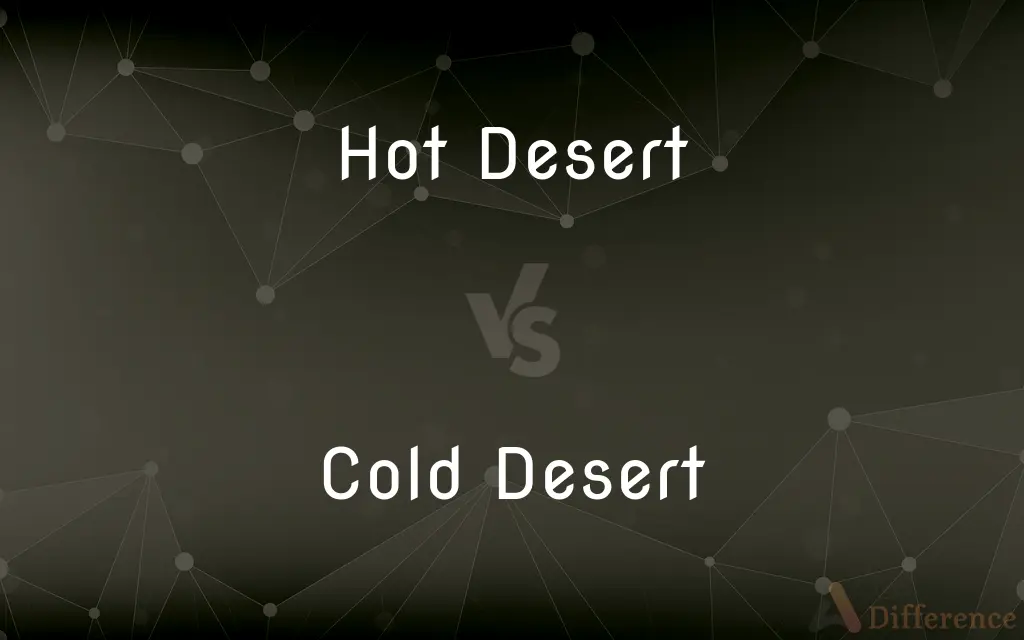Hot Desert vs. Cold Desert — What's the Difference?
By Tayyaba Rehman — Published on December 2, 2023
Hot deserts are typically characterized by high temperatures and low precipitation, while cold deserts have cold winters and may receive snow.

Difference Between Hot Desert and Cold Desert
Table of Contents
ADVERTISEMENT
Key Differences
Hot Desert and Cold Desert are terms used to describe two main types of desert ecosystems based on temperature. A hot desert, as the name suggests, experiences high temperatures year-round. In contrast, a cold desert may have cold winters, often with snow.
Hot Desert and Cold Desert climates differ significantly. Hot deserts usually see very little rainfall, leading to arid landscapes with sparse vegetation. Cold deserts, on the other hand, may receive more precipitation in the form of snow, and this can sometimes support a different set of plant and animal life.
Hot Desert and Cold Desert locations around the world include places like the Sahara for the former and parts of Antarctica for the latter. While hot deserts are often found at low latitudes, cold deserts might be located at high latitudes or high altitudes.
Hot Desert and Cold Desert terrains have adapted to their unique conditions. The flora and fauna in a hot desert have evolved to withstand extreme heat and prolonged dry spells. Conversely, in a cold desert, organisms have developed strategies to survive freezing temperatures.
Hot Desert and Cold Desert are important to study as they showcase nature's adaptability. Despite the harsh conditions, both hot and cold deserts support diverse ecosystems that have evolved specialized survival mechanisms.
ADVERTISEMENT
Comparison Chart
Temperature
Typically high temperatures year-round.
Cold winters, often with snow.
Precipitation
Low rainfall, leading to prolonged dry spells.
May receive more precipitation as snow.
Typical Locations
Sahara, Arabian Desert.
Antarctica, parts of Central Asia.
Flora and Fauna
Adapted to withstand extreme heat.
Adapted to survive freezing temperatures.
Human Adaptations
Nomadic lifestyles, light clothing.
Heavier clothing, adapted housing structures.
Compare with Definitions
Hot Desert
A landscape dominated by sand dunes, rocky outcrops, and sparse vegetation due to excessive heat.
Oases in the hot desert are vital for both wildlife and human settlements.
Cold Desert
A landscape where the ground may be covered in snow or ice for extended periods.
Traveling through the cold desert requires preparation against the elements.
Hot Desert
A region where evaporation rates exceed precipitation rates.
Water scarcity in the hot desert makes survival a challenge.
Cold Desert
A region with dry conditions and significant temperature drops, especially during winter.
The Gobi is a cold desert located in Asia.
Hot Desert
An area receiving less than 250 mm of rain annually, with high temperatures.
The Mojave is another hot desert found in the USA.
Cold Desert
A desert characterized by cold temperatures, often receiving snow.
Antarctica, while icy, is considered a cold desert.
Hot Desert
A barren area with high temperatures and minimal rainfall.
The Sahara is a prime example of a hot desert.
Cold Desert
An area receiving limited precipitation, often in the form of snow or frost.
The cold desert nights can be breathtakingly beautiful with clear starry skies.
Hot Desert
An ecosystem characterized by extreme heat and scanty vegetation.
Camels have adapted to the harsh conditions of the hot desert.
Cold Desert
An ecosystem with low temperatures and limited vegetation, especially in winter.
The plants in the cold desert have adapted to the chilly environment.
Common Curiosities
Can plants grow in a Hot Desert?
Yes, certain plants like cacti have adapted to the harsh hot desert conditions.
Where can you find a Cold Desert?
Cold deserts can be found in regions like Antarctica and parts of Central Asia.
Is snow common in a Cold Desert?
Yes, cold deserts often receive snow or frost.
What's the primary difference between Hot Desert and Cold Desert?
The main difference is temperature, with hot deserts being warm year-round and cold deserts having chilly winters.
Why are Hot Deserts so dry?
Hot deserts are dry due to high evaporation rates and atmospheric conditions that prevent cloud formation.
Are there any large cities in a Hot Desert?
Yes, cities like Phoenix and Dubai are located in hot deserts.
How do people adapt to living in a Cold Desert?
In cold deserts, people wear heavy clothing and have specialized housing structures.
Is it possible for a desert to be both hot and cold?
Some deserts, like the Great Basin in the U.S., can have hot summers and cold winters.
What defines a Hot Desert?
A hot desert is defined by its high temperatures and low rainfall.
How do animals adapt in a Hot Desert?
In hot deserts, animals adapt by being nocturnal or having features to retain water.
Can it rain in a Cold Desert?
Yes, but precipitation in cold deserts is often in the form of snow.
Which is larger: Hot Desert or Cold Desert?
In terms of land area, cold deserts like Antarctica can be larger than individual hot deserts.
What causes a Cold Desert's temperature to be low?
Cold deserts may be located at high latitudes or altitudes, resulting in low temperatures.
Can humans easily survive in a Hot Desert without preparation?
No, surviving in a hot desert requires adequate water, shade, and protection against the elements.
Are there any benefits to Cold Desert environments?
Cold deserts play a crucial role in regulating Earth's climate and supporting unique biodiversity.
Share Your Discovery

Previous Comparison
Needed vs. Needing
Next Comparison
Samoan vs. PolynesianAuthor Spotlight
Written by
Tayyaba RehmanTayyaba Rehman is a distinguished writer, currently serving as a primary contributor to askdifference.com. As a researcher in semantics and etymology, Tayyaba's passion for the complexity of languages and their distinctions has found a perfect home on the platform. Tayyaba delves into the intricacies of language, distinguishing between commonly confused words and phrases, thereby providing clarity for readers worldwide.













































